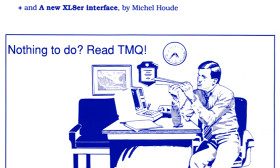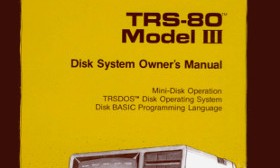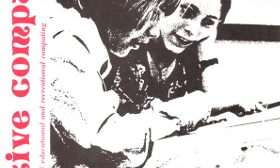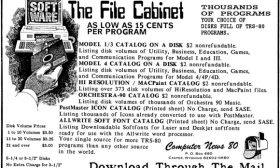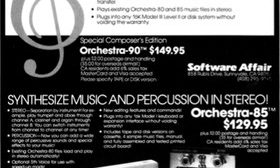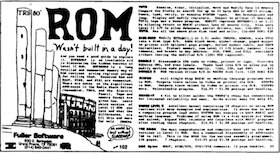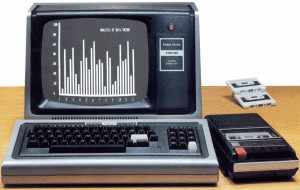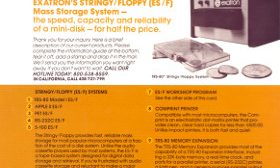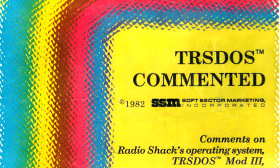The MISOSYS Quarterly, better known as TMQ, was the official newsletter for MISOSYS, a software company based in Sterling, Virginia. It was published by Roy Soltoff, the “system designer of TRSDOS 6.0” and co-founder of Logical Systems (the creators of LDOS and LS-DOS). The MISOSYS Quarterly was far more than just a company newsletter, and was one of the best technical resources for the TRS-80 Model III and Model 4. Along with TRSTimes and Computer News 80, it was one of the last print publications for the TRS-80.
The MISOSYS Quarterly had similarities to an earlier MISOSYS newsletter, Notes from MISOSYS. But The MISOSYS Quarterly was far more ambitious, with outside advertising, articles by external authors, and information about non-MISOSYS products.
(Read more...)
Model III TRSDOS, better known as TRSDOS 1.3, was Radio Shack’s official disk operating system for the TRS-80 Model III. It was available either bundled with a disk-based Model III, as part of Radio Shack’s floppy disk upgrade, or purchased as a separate product (catalog number 26-0312) for $14.95. Almost everyone who had a disk-based Model III had a copy of Model III TRSDOS.
Unlike Model I TRSDOS, which was written under contract by Randy Cook, Model III TRSDOS was developed in-house by Radio Shack. It was at least partially based on Model II TRSDOS, and shares many of the same commands. Here is a description from a 1981 Radio Shack catalog:
(Read more...)
ED-IT for the Model 4 is a very powerful text editor for the TRS-80 Model 4. It was written by Mark Reed and was first released on June 17, 1991. ED-IT cost $17.95 and was distributed by Computer News 80 of Casper, Wyoming.
There were many capable editors for the Model 4. Most Z80 assembler packages included their own editors (ALEDIT in ALDS and SAID in MRAS were notable examples). The LS-DOS 6.3 operating system even included a simple text editor named TED/CMD.
But ED-IT contains many useful features for programmers and is suitable for use with multiple programming languages or simple word processing. Despite its many features, it has one of the largest text buffers of any Model 4 editor. As Harold J. Hendriks wrote in the January 1996 issue of Computer News 80:
ED-IT is the CHAMP when it comes to editing large files. It can accept, load and edit ASCII text files up to 47K in size.
(Read more...)
Creative Computing was a very popular early computer magazine and was one of the few to predate microcomputers themselves. It was created by David Ahl and published its first issue in October 1974. David Ahl once described Creative Computing as “the first personal computing magazine.” Although it was created to promote educational computing, it became one of the best magazines for hobbyists.
While working at Digital Equipment Corporation, David Ahl edited EDU, a newsletter aimed at educational users of Digital Equipment’s computers. (This was also when he first published his book 101 BASIC Computer Games). EDU became quite successful as the use of computers in education expanded. But Ahl envisioned a more generic magazine for educational users of all computers, not just those sold by Digital Equipment. When Ahl left Digital Equipment in July 1974, he developed this idea into Creative Computing
(Read more...)
The File Cabinet was the largest collection of TRS-80 public domain and shareware software ever assembled. At its height, it was described as offering “15,000 programs for the Model I/III/4/4P/4D.” Disks from the collection were sold from 1987 to 2009.
The File Cabinet was started in 1987 by Tim Sewell, a sysop of the Tandy RoundTable on the GEnie online service. It began as Sewell’s collection of TRS-80 files submitted to GEnie and that he had downloaded from BBS’s around the country. He described the File Cabinet as a “hobby that I enjoy doing” in the November 1989 issue of Computer News 80:
The File Cabinet was created out of a love for this computer and the chance through magazines who believed in my project to get software into the hands of the people who don’t have access to or use a modem to call BBS systems.
(Read more...)
Orchestra-90, also known as Orch-90, was a popular hardware sound add-on for the TRS-80 Model III and Model 4, and later the Color Computer. It was created and sold by Software Affair of Sunnyvale (originally Santa Clara), California, along with Orchestra-85, the equivalent add-on for the TRS-80 Model I. It became more popular when Radio Shack began selling a licensed version of Orchestra-90 in 1984. At its peak of popularity, there were over a thousand song files available from CompuServe, Delphi, and BBS’s around the world.
Both Orchestra-90 and Orchestra-85 were enhanced versions of Software Affair’s earlier Orchestra-80. Orchestra-85 (the Model I version) was introduced in 1981 for $129.95. Orchestra-90 (the Model III version) followed a few months later for $149.95. Users who wanted to upgrade the Orchestra-80 could send their unit to Software Affair and pay $69.95 (plus $2.00 for shipping and handling) to exchange it for an Orchestra-85.
(Read more...)
Probably the biggest design mistake Radio Shack made with the TRS-80 Model I was their decision to use solder-coated tin contacts (instead of silver or gold) on the Model I and Expansion Interface connectors. These solder-coated contacts tended to oxidize over time, leading to reliability problems and unexpected reboots. The usual solution was periodically to use a pink rubber eraser to remove the oxidation. This was supposed to be done every month, but many people did it every week, or even every day.
There were also several hardware solutions to the problem. The best known was the Gold Plug 80 from E.A.P. Company. Gold Plug 80 worked by installing gold-plated contacts over the originals. This completely eliminated the reliability problems. The only downside was that the double set of contacts did extend slightly from the case.
A lesser known way of stopping the reboots was Silver-It, sold by Roger Fuller through Fuller Software of Grand Prairie, Texas. Silver-It worked by recoating the oxidizing contacts with silver.
(Read more...)
The Radio Shack TRS-80 Microcomputing System (catalog number 26-1001), later known as the TRS-80 Model I, was introduced by Radio Shack on August 3, 1977. It made computer history as one of the first mass marketed, fully assembled microcomputers. The initial price was $599.95, which included a typewriter-style (not membrane) keyboard, monitor, and cassette recorder.
The TRS-80 (which became known as the Model I after the Model II was introduced in 1979) was created by Don French and Steve Leininger. It ran a Zilog Z80 at 1.77 MHz and came with 4K of RAM, and a 4K ROM of what was called Level I BASIC. Only uppercase characters could be displayed, and the only means of storage was a cassette recorder. Despite these limitations, the TRS-80 was enormously successful. The initial production run sold out in less than a month, and it took almost a year for Radio Shack to catch up with the demand. Radio Shack sold 100,000 TRS‑80 computers in 1978, over four times its nearest competitor.
(Read more...)
The Exatron MM+, also known as the Exatron Memory Plus Expansion, was an alternative to the Radio Shack Expansion Interface for the TRS-80 Model I. It was designed and sold by Exatron of Sunnyvale, California for use with their floppy disk storage alternative, the Exatron Stringy Floppy. Despite the fact that it was barely advertised and seems to have been only sold briefly in 1981, the Exatron MM+ remains one of the best remembered Expansion Interface alternatives.
The Exatron MM+ was aimed at users of alternative Model I storage options, such as the Exatron Stringy Floppy, the Meca BETA-80, or the JPC Products TC-8. Unlike the Radio Shack Expansion Interface, the Exatron MM+ didn’t include a floppy disk controller. But it did add additional memory, a parallel port, and a serial port. Unlike the Microtek MT-32, another lightweight Expansion Interface alternative, the Exatron MM+ also extended the Model I expansion bus. This meant that peripherals that connected to the bus, such as the Stringy Floppy or the BETA-80, could still be attached to the MM+.
(Read more...)
There were many popular books published back in the late 1970’s and early 1980’s that examined the TRS-80 Model I in detail. But there were far fewer books that served the same purpose for the TRS-80 Model III.
TRSDOS Commented, published by Soft Sector Marketing with “decoding and data entry” by Rick Papo, was one of those few. The book’s cover described it as “a must for every Mod III owner.” It included a complete disassembly for the code comprising Model III TRSDOS (minus Disk BASIC) in much the same way as the IJG book TRSDOS 2.3 Decoded and Other Mysteries did for Model I TRSDOS. One notable difference was that the disassembled listings in TRSDOS 2.3 Decoded and Other Mysteries were published with full permission from Tandy Corporation. Soft Sector Marketing had no such permission and included this disclaimer at the beginning of TRSDOS Commented:
(Read more...)
